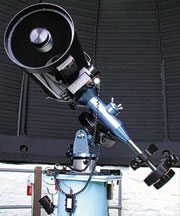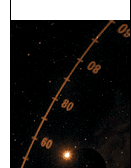| Around
Tappan Square
Charting
the Stars
by Yvonne Gay
When
Peters Hall Observatory assistant Mike Williams learned that a Celestron
14-inch Schmidt-Cassegrain telescope would soon be on the market,
he wasted no time in helping to obtain it for Oberlin.
"The
telescope came from an astronomer who had owned it for several years,
but thought it too big to drag out of his home, place in a field,
and set up. He probably used it only three or four times,"
says associate professor of astronomy Daniel Stinebring, who carefully
removes a plastic covering to reveal this latest acquisition by
the newly renamed Department of Physics and Astronomy.
 Purchased
at the bargain price of $7,500 last May, the C-14 replaces the department's
10-year C-11, which is pegged for field study use once a portable
mount is bought. Purchased
at the bargain price of $7,500 last May, the C-14 replaces the department's
10-year C-11, which is pegged for field study use once a portable
mount is bought.
Unlike its predecessor, the C-14's aperture offers more light-gathering
ability and greater details in lunar and planetary observation.
It's also the largest of the Schmidt-Cassegrain telescopes.
More impressive, however, is its drive. "A telescope drive's
main purpose is to very accurately counteract the Earth's
rotation, so that once you have an object lined up in the center
of the telescope, it will stay lined up," Stinebring explains.
"This drive has a mechanical set up that can not only track
very accurately, but can also carry a lot of weight, enabling us
to hang accessories, like an electronic camera, off the telescope."
Also
significant in the instrument's purchase is its Losmandy equatorial
mount, which replaces an older, much shakier fork mount. To illustrate
its effectiveness, two people jumped on the floor near the telescope
while someone else looked through the eyepiece. The mount was able
to diminish vibrations almost instantaneously, a helpful quality,
particularly when many people are in the observatory together.
The
C-14 arrived at Oberlin just as the physics department was wrapping
up a two-year revamp aimed at improving the facilities for teaching
introductory astronomy courses. With help from a 1978 bequest from
the John W. Taylor family, the department was able to upgrade equipment,
install the Peters Hall planetarium, and hire Williams and Lee Lumpkin
as observatory assistants. An Oberlin resident, Williams spearheaded
the development of the planetarium in Peters, which called for installation
of a dome and the purchase of a planetarium projector and other
equipment.
One
of the reasons we bought the equipment is that we are finally offering
a lab course in astron- omy," Lumpkin says. "Last semester,
students in the astronomy course took six sessions in the planetarium.
Now we have the opportunity for eight or nine viewings here in the
observatory."
"And
that's where having Lee and Mike as part of the team makes
such a difference," Stinebring adds. "They have backgrounds
in amateur astronomy, which allows them to get other people familiar
with the night sky."
Stinebring
says that increased student interest in astronomy over the past
five years has prompted other changes as well, including a departmental
name change. Until recently, astronomy courses were offered through
the Department of Physics. Now, students who are interested in exploring
distant planets are directed to the Department of Physics and Astronomy.
Projects are underway to further improve lab sessions and advanced
classes, and the observatory opened for public viewing this spring.
"We
have plans to let some advanced students use the C-14 for training
projects, but that will come a little later," Stinebring says.
For now, introducing students to the Andromeda galaxy, constellations,
globular clusters, "and all of the other beautiful and mind-stretching
things that can be seen through a telescope" is satisfying
enough.
|








 Purchased
at the bargain price of $7,500 last May, the C-14 replaces the department's
10-year C-11, which is pegged for field study use once a portable
mount is bought.
Purchased
at the bargain price of $7,500 last May, the C-14 replaces the department's
10-year C-11, which is pegged for field study use once a portable
mount is bought.